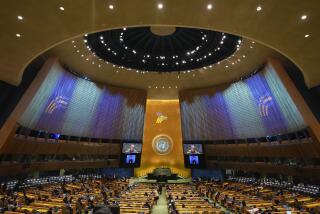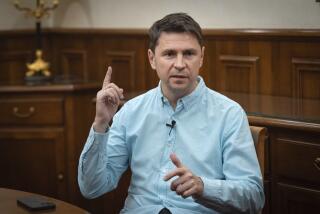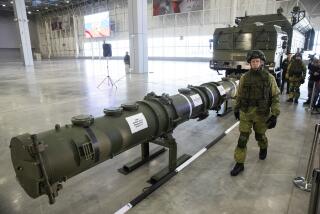U.S., Russia to Cut Nuclear Arms
WASHINGTON — The United States and Russia agreed Monday to cut their nuclear arsenals by two-thirds over the next decade, completing a treaty that President Bush said “will liquidate the legacy of the Cold War.”
If confirmed by the Senate and Russia’s State Duma, the treaty will reduce the stockpiles of deployed nuclear warheads from the current level of 5,000 to 6,000 on each side to a range of 1,700 to 2,200.
Bush and Russian President Vladimir V. Putin are expected to sign the pact next week in Moscow.
“This is good news for the American people,” Bush said. “It’ll make the world more peaceful and put behind us the Cold War once and for all.”
Some experts, however, cautioned that the impact the treaty would have on each country’s ability to wage nuclear war might be less significant than such a sizable reduction would suggest.
Perhaps most important, although the agreement requires a sharp reduction in the number of deployed warheads, none have to be destroyed.
Experts anticipate that each country will dismantle many weapons. But the weapons’ plutonium can be reused, thousands of warheads are expected to be in readily accessible storage, and each nation will be allowed to withdraw from the treaty with three months’ notice. Also, the pact does not address the numbers of bombers, missiles and submarines that can deliver warheads to targets on short notice.
The treaty’s most far-reaching significance may be to formalize the dramatic change that has taken place over the last decade in the U.S.-Russian relationship. Two countries with sufficient nuclear weapons to destroy the world many times over are taking a large step back from half a century of confrontation.
“The new era will be a period of enhanced mutual security, economic security and improved relations,” Bush said.
Putin said he was “satisfied with the joint work.”
He praised Bush for pressing for the pact’s completion, saying that “without the interested, active position of the American administration and the attention of President Bush, it would have been difficult to reach such agreements.”
Although diplomats began discussing the treaty in August, a White House aide said, the push for the arms cut was given new impetus in November, when Bush and Putin met in Washington and the president’s ranch near Crawford, Texas.
Bush said then that the United States would undertake the cuts on its own and that he saw no need for a treaty. Putin matched the proposal with promised Russian cuts but said he wanted a formal treaty to guard against a subsequent U.S. administration deciding to ignore the agreement.
Putin got that document when U.S. and Russian negotiators finished their work on it in Moscow early Monday.
“A few months ago, the United States did not want to hear about any legally binding agreement,” said Andrei A. Piontkovsky, director of the Independent Institute for Strategic Studies, a think tank in Moscow. “The very fact that such an agreement is about to be signed is a major victory of Russian diplomacy.”
The most recent arms control agreements were reached roughly a decade ago.
A strategic arms reduction agreement signed by then-President George Bush and Soviet President Mikhail S. Gorbachev in 1991 set the current limits of roughly 6,000 nuclear warheads per side. A second agreement, reached less than two years later, would have cut the weapons to no more than 3,500. But it never went into effect.
Unlike those complex and lengthy treaties, the new agreement is only about three pages long. It leaves to each side decisions about how many warheads will be dismantled, how many will be placed in what is called “deep storage” and how many will be kept on standby.
Also, each country is free to determine its mix of weapons among land-based missiles, submarine-based missiles and bombers. In the White House view, this freedom demonstrated that the two countries do not see each other as threats.
The agreement leaves unresolved how compliance with the treaty, which will require approval by two-thirds of the Senate, will be monitored. However, it will draw from the 1991 pact, which requires on-site inspections and military sites in each country.
The signing of the treaty is likely to be the centerpiece of Bush’s visit to Moscow and St. Petersburg at the end of next week.
While the agreement builds on the cooperative relationship Bush and Putin have established, sore points remain between the two countries. The Russians were angered by the recent U.S. withdrawal from the 1972 Antiballistic Missile Treaty so that the administration can work on a national missile defense system.
U.S. officials remain concerned that Russia’s aging nuclear weapons are too loosely guarded to keep them from falling into the hands of terrorists or other nations, and that Russia is turning its nuclear technology into a cash-earning export.
Initial reaction from Congress to the new treaty was positive.
Sen. Joseph R. Biden Jr. (D-Del.), chairman of the Senate Foreign Relations Committee, praised the agreement and said he hoped to begin hearings on it this summer.
Sen. Jesse Helms of North Carolina, the committee’s senior Republican, who in the past has been skeptical of arms control agreements, was said by an aide to have no immediate objections.
The pact could face a harder time winning approval in Moscow.
Because Putin had hoped that the treaty would ensure that each country would destroy some warheads, this failure could become a political liability for him. Some retired military leaders already consider him too accommodating to Washington.
As a result, Piontkovsky said, the treaty may encounter some difficulty in the State Duma, where Putin can generally summon a comfortable majority.
The Russian president will face complaints “about the ‘sellout’ of national interests,” Piontkovsky said. He also said “the military-industrial lobby will scream on every corner about the unacceptable low level of ... warheads.”
Alexander A. Konovalov, president of the Institute for Strategic Assessment, another think tank, agreed that confirmation may be a problem in Moscow.
“Duma deputies are populists by nature, and they will do everything possible to retain their posts and gain popularity,” Konovalov said. “For them, any deal with the Americans is an object worthy of criticism, since it’s what the public likes to hear.”
Dimitri K. Simes, president of the Nixon Center, a Washington think tank, said the pact “doesn’t really commit either side to things they weren’t likely to do anyway.”
Still, he said that the Russians overcame Bush’s initial objections to negotiating a formal treaty.
“You may be cynical and say, ‘Who cares?’ But clearly the Russians were able to change the U.S. position literally 180 degrees,” Simes said.
*
Gerstenzang reported from Washington and Daniszewski from Ekaterinburg, Russia.
More to Read
Sign up for Essential California
The most important California stories and recommendations in your inbox every morning.
You may occasionally receive promotional content from the Los Angeles Times.










